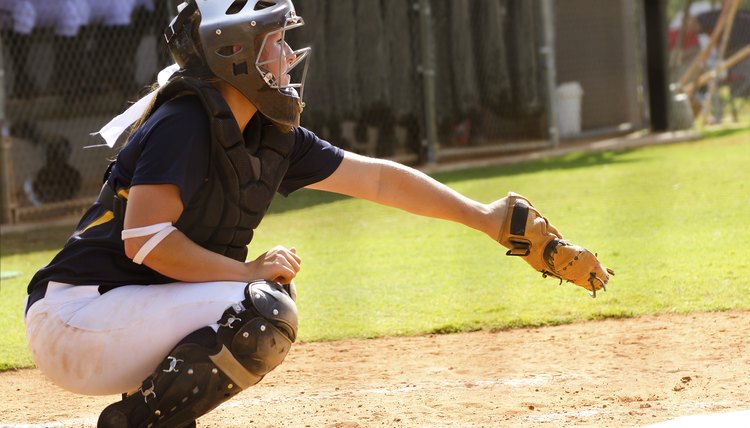How to Play Catcher in Softball

In softball, catcher is one of the easiest positions to play – or one of the most difficult. That depends on whether the game is slow pitch or fast pitch. In slow-pitch softball, the catcher’s job mostly involves throwing the ball back to the pitcher and making the occasional play at the plate. Fast-pitch softball requires more equipment and a lot of skill for the catcher to do the job effectively.
Slow-Pitch Responsibilities
Slow-pitch softball features pitches that are lobbed toward the plate; with no leading from a base, or stealing a base, allowed from base runners. While some leagues require catchers to wear a mask and possibly a chest protector, otherwise catching is considered the easiest fielding position to play, since slow tappers in front of the plate are rare, and bunting generally is not allowed. As long as the catcher has enough arm strength and accuracy to toss the ball back to the pitcher, that’s the vast majority of the needed skills. Any fielder’s glove will do when manning the position.
Fast-Pitch Challenges
In fast-pitch softball, catcher is as difficult a position to play as it is in the higher levels of baseball. The ball’s coming to the plate very fast, and the softball pitcher is positioned closer to the plate when starting the pitching motion than what occurs in baseball. As a result, catching an elite softball pitcher is much like catching a major league baseball fastball. Fast-pitch softball catcher gloves therefore are heavily padded to reduce the likelihood of bruising the glove hand.
Helping the Pitcher
Softball catchers help their pitchers look good. Elite fast-pitch catchers learn how to frame pitches by catching balls in a way that can make borderline pitches look like strikes. They also save runs by blocking pitches in the dirt or way off the corners, preventing base runners from taking extra bases. They're responsible, in many cases, for calling pitches; for knowing the tendencies of the hitters; and for crafting the strategy to prey on batter weaknesses.
Controlling Base Runners
Fast-pitch softball allows base runners to steal, so a catcher needs to be ready to come up firing. This also requires an element of self-awareness and strategy. In some situations, you’re better off letting the runner have the base and focusing on the batter. For example, with two outs and runners on first and third, throwing to second to catch a base runner trying to steal may allow the lead runner to score, whereas pitching to the batter may result in a strikeout and a scoreless inning.
Leadership Role
The pitcher may get the glory, but the catcher essentially serves as the quarterback. Catchers are singularly stationed to position the defense and, because they’re facing the action, they direct fielders on where to go with the ball. As a result, catchers should be strong and loud communicators, unafraid to yell directions on where the ball is going and where the play should be. Catchers also may need to manage the game, going out to the mound to settle a struggling pitcher or holding the ball an extra few seconds to slow down one who’s starting to rush.
